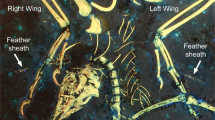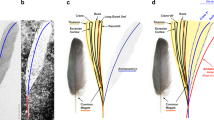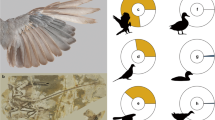Abstract
Replying to Richard O. Prum Nature 468, 10.1038/nature09480
Prum1 identifies the unusual feathers in the smaller Similicaudipteryx specimen as immature, and suggests that the different morphologies preserved in the smaller and larger specimens represent different growth stages of a single feather type rather than successive feather generations of different types. Although this new proposal is very interesting, we do not agree that it is better supported by the available data than our original interpretation2.
Similar content being viewed by others
Main
A feather of any generation can be expected to show different morphologies in the course of its growth3, as noted by Prum1. During early growth, the feather will be enclosed in a long sheath. Subsequently, the sheath will begin to open from the distal end, revealing the pennaceous feather. For simplicity, we refer to feathers at this early stage of opening as emergent feathers. The proximally ribbon-like pennaceous feathers (PRPFs) in the Similicaudipteryx specimen are superficially similar to the emergent feathers of extant birds3, but they are apparently different in relative size. Because feather growth is still far from complete when the sheath begins to open, emergent feathers are proportionally small3, and this is particularly true in early feather generations. The overall immaturity of the smaller Similicaudipteryx specimen implies that its plumage would have been of an early generation2, so that emergent feathers of large size would be particularly surprising in this individual. However, the PRPFs of the smaller Similicaudipteryx are longer than the tibiotarsus, greatly exceeding the proportional length of early-generation emergent feathers in modern birds.
Also, the ribbon-like portion of a typical PRPF in the smaller Similicaudipteryx specimen is only slightly narrower than the pennaceous portion, and its width considerably exceeds the length of the associated caudal vertebra. In contrast, the ensheathed portion of an emergent feather of an extant bird is much narrower than the pennaceous portion. Also, the identification of all rectrices and remiges in the Similicaudipteryx specimen as emergent feathers would imply that Similicaudipteryx moulted all of its flight feathers simultaneously, in contrast to the sequential moulting of extant birds1. The interpretation by Prum1 of simultaneous moulting as a primitive condition present in non-avian dinosaurs is interesting, but at face value this is nevertheless an obstacle to interpreting the plumage of the smaller Similicaudipteryx specimen as a generation of emergent feathers. Finally, because new feathers physically displace old feathers during the process of moulting, a displaced mature feather will often be found hanging from the tip of the emergent feather that is replacing it. The total absence of previous-generation feathers associated with the PRPFs of Similicaudipteryx represents another piece of evidence indicating that the PRPFs are unlikely to represent emergent feathers, unless the replacement process was substantially different from that seen in extant birds.
Prum1 emphasizes some differences between the PRPFs of the Similicaudipteryx specimen and those of basal birds and the non-avian maniraptoran Epidexipteryx. We noted these differences in our original study2, but Prum’s alternative interpretation led us to reconsider the nature of the PRPFs in the Similicaudipteryx specimen and those in basal birds and Epidexipteryx2. The ribbon-like portion of the PRPFs in basal birds and Epidexipteryx appears to represent an extremely broad rachis, given that the definite rachis of the pennaceous portion is identifiable as a tapering extension of the entire ribbon-like portion4. Under this interpretation, the median line that typically extends along the ribbon-like portion of the feather, and which was previously identified as a rachis5, would actually represent a ventral furrow running along the rachis as in modern birds.
In contrast to both the broad proximal rachises of basal birds and Epidexipteryx, and the horny feather sheaths referred to by Prum1, the ribbon-like portions of the PRPFs of the smaller Similicaudipteryx specimen may represent hollow structures similar to the broad monofilaments seen in more basal theropods6. Admittedly, two-dimensional preservation makes it difficult to judge which identification is correct, but further early juvenile Similicaudipteryx specimens with normal flight feathers would support Prum’s interpretation. Nevertheless, differences in feather ontogeny between Mesozoic and extant taxa indicate that analogies involving specific feather structures should be drawn only with extreme caution.
References
Prum, R. O. Moulting tail feathers in a juvenile oviraptorisaur. Nature 468 10.1038/nature09480 (2010)
Xu, X., Zheng, X. & You, H. Exceptional dinosaur fossils show ontogenetic development of early feathers. Nature 464, 1338–1341 (2010)
Lucas, A. M. & Stettenheim, P. R. Avian Anatomy: Integument (US Dept of Agriculture, 1972)
Zheng, X. T. The Origin of Birds 55–58 (Shandong Science and Technology Press, 2009)
Zhang, F., Zhou, Z., Xu, X., Wang, X. & Sullivan, C. A bizarre Jurassic maniraptoran from China with elongate ribbon-like feathers. Nature 455, 1105–1108 (2008)
Xu, X., Zheng, X. & You, H. A new feather type in a nonavian theropod and the early evolution of feathers. Proc. Natl Acad. Sci. USA 106, 832–834 (2009)
Author information
Authors and Affiliations
Ethics declarations
Competing interests
Competing financial interests: declared none.
Rights and permissions
About this article
Cite this article
Xu, X., Zheng, X. & You, H. Xu et al. reply. Nature 468, E2 (2010). https://doi.org/10.1038/nature09481
Published:
Issue Date:
DOI: https://doi.org/10.1038/nature09481
This article is cited by
-
A Mesozoic bird from Gondwana preserving feathers
Nature Communications (2015)
-
On the identification of feather structures in stem-line representatives of birds: evidence from fossils and actuopalaeontology
Paläontologische Zeitschrift (2012)
Comments
By submitting a comment you agree to abide by our Terms and Community Guidelines. If you find something abusive or that does not comply with our terms or guidelines please flag it as inappropriate.



